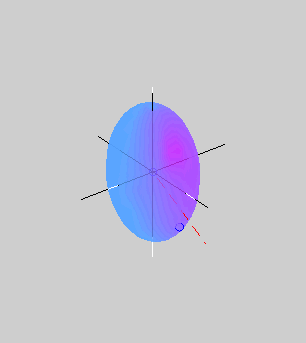I've been doing some more experiments in Orbiter to try and get my head around how precession works - but I'm not seeing the behaviour I expect.
Probably because my understanding of angular momentum is wrong, but I'll get to that later.
First thing I noticed is that the behaviour at TimeWarp 1x is different to that at TimeWarp 10x, 100x or 1000x.
If anyone can be bothered, perhaps you can try the following experiment:
1. Make yourself a simple .cfg based spacecraft with inertia parameter
Inertia = 1 1 2
I used the following .cfg
Code:
; === Config file for spintester ===
ClassName = spintester
Size = 5.0
EnableFocus = TRUE
MeshName = ldef
Mass = 802
TouchdowPoints = 0 -2.93 9 -2 -2.93 -8 2 -2.93 -8
Inertia = 1 1 2
CrossSections = 4 4 4
PropellantResource1 = 150
ISP = 3000
MaxAttitudeThrust = 20
The ldef mesh is for visual ref, the Inertia values are chosen to make the maths easier when trying to do calulations.
2. Using the Scenario editor, put your vessel far out in space, away from any planetary gravity gradients, etc.
3. Set the x,y,z angular velocities to zero and set the orientation angles to zero(so you know where the z-axis was pointing when you start the rotation). Enable the Ecliptic Grid and Vessel Axes on the "Visual Helpers" tab(so you can see whats going on)
4. Now set the angular velocities to:
x = 0.8, y = 0, z = 90 (so your vessel is spinning rapidly around the z-axis and there is a very small pitch-up component)
Keep the TimeWarp at 1x - what do you see? I don't see any precession at all i.e. the z-axis rotates in one plane, describing a great-circle around the sky (or you could say it describes a cone with an opening angle of 180deg)
Now, press pause and set the TimeWarp to 10x.
Repeat steps 3 and 4.
At TimeWarp 10x (or 100x, 1000x), I see a clear precession effect with the z-axis describing a cone with opening angle of ~90deg.
(note: switch back to TimeWarp 1x while the precession is happening and it continues to precess)
I get this result consistently - anyone else get the same? It doesn't seem right to me - I would expect to see the precession effect at TimeWarp 1x as well as higher values (ignoring values > 1000x, I know the angular velocity propagation limiters kick in at high values)
OK, on to my next point - even when I do see the precession effect happening, it's not what I expect.
From what I've read, I thought that the precession axis is the Total Angular Momentum vector - is that right?
If yes - why can't I find the total angular momentum vector by summing the angular momentum vectors along the vessels x,y,z axes?
For instance in my experiment above, I thought the components of the total angular velocity vector would be:
x = PMI * mass * angular velocity = 1 * 952kg * (0.8 * PI/180)rad/s
y = PMI * mass * angular velocity = 1 * 952kg * 0 = 0
z = PMI * mass * angular velocity = 2 * 952kg * (90 * PI/180)rad/s
and the angle between this vector and the z-axis would be:
atan(x/z) = atan(0.8/180) = 0.254deg
But as you can see if you do the experiment above, the precession axis is ~45deg away from the z-axis.
Yech! I don't grok this at all! Can anyone confirm if Orbiter is handling angular momentum as it should? (and I'll go back to reading up on precession!)
Attached is a .pdf about the subject (can't remember where I found it, so I'll leave it here)
Thanks,
Brian

